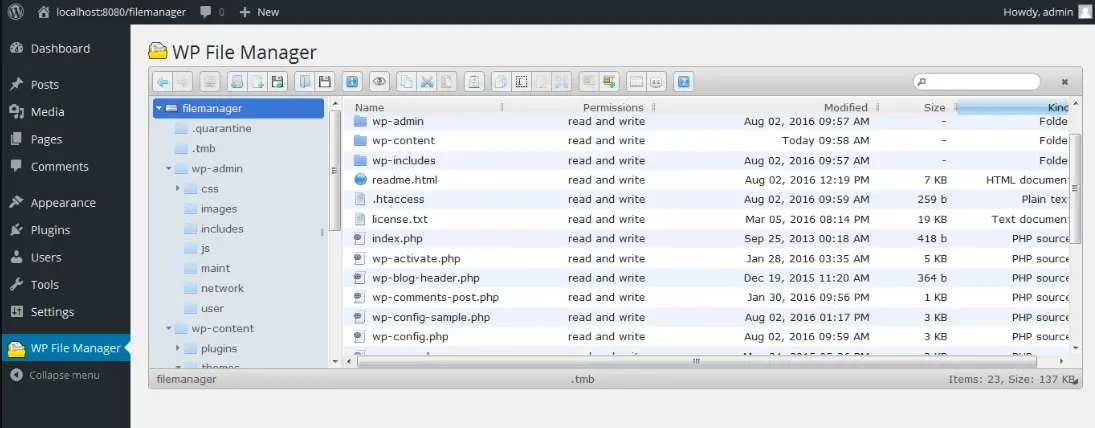Wondering how to upload files to WordPress? There’s a couple methods to doing this - one with and without plugins. In this article, you’ll learn two ways on how to upload files to WordPress.
How To Upload Files to WordPress Without Plugins
Uploading files to WordPress without using a plugin can be accomplished through the WordPress dashboard and via FTP (File Transfer Protocol). These methods provide more control over file management and reduce reliance on additional plugins, which can sometimes slow down your website or introduce security vulnerabilities.
How to Upload Files to WordPress Media Library
- Prepare Your Files
- Log in to Your WordPress Dashboard
- Access the Media Library
- Upload Files to WordPress Using the Media Library
Prepare Your Files
Before you upload, ensure they are properly organized on your local computer. This organization can help you easily locate and manage files after uploading. You can create a folder on your computer and organize your files within it.
Log in to Your WordPress Dashboard
Navigate to your WordPress website's admin area by entering your website URL followed by "/wp-admin" (example - www.yourwebsite.com/wp-admin). Log in with your username and password to access the WordPress dashboard.
Access the Media Library
In the WordPress dashboard, locate and click on the "Media" option in the left-hand sidebar. This will open the Media Library, where you can manage all the media files uploaded to your WordPress site.
Upload Files to WordPress Using the Media Library
Once in the WordPress Media Library, click on the "Add New" button located near the top of the page.
This action will open the media uploader interface. Here, you can either drag and drop files from your computer into the upload area or click on the "Select Files" button to browse your computer for files.
After selecting the files you want to upload, Media Library uploader will begin to upload the files automatically. You'll see a progress bar indicating the upload status for each file.
Once the upload is complete, the files will appear in the Media Library. You can click on each file to view additional details and make any necessary adjustments, such as adding alt text or captions.
How to Upload Files to WordPress via FTP
In addition to using the Media Library, you can upload files to WordPress using FTP. This method is useful for uploading large files or when you want more control over the file management process.
- Obtain FTP Credentials
- Connect to Your Website via FTP
- Navigate to the WordPress Directory
- Upload Files
- Verify Upload
Obtain FTP Credentials
First, you'll need to obtain your FTP credentials from your web hosting provider. These credentials typically include a hostname, username, password, and port number.
Connect to Your Website via FTP
Download and install an FTP client such as FileZilla, Cyberduck, or WinSCP.
Open the FTP client and enter the FTP credentials provided by your web hosting provider.
Click on the "Connect" button to establish a connection to your website's server.
Navigate to the WordPress Directory
Once connected via FTP, you'll see a directory structure representing your website's files. Navigate to the directory where WordPress is installed. This is typically the "public_html" or "www" directory, but it may vary depending on your hosting setup.
Upload Files
Locate the folder within the WordPress directory where you want to upload your files. This could be the "wp-content/uploads" directory for media files or a custom directory if you're uploading other types of files.
Drag and drop the files from your local computer into the appropriate directory on the server.
Wait for the FTP client to transfer the files to the server. The transfer progress will be displayed in the FTP client interface.
Verify Upload
Once the file transfer is complete, you can verify that the files have been successfully uploaded by checking the destination directory on the server.
When you choose to upload files without a plugin gives you more control over your website's media management and reduces reliance on additional software. By following the steps outlined above, you can efficiently upload files using either the WordPress dashboard or FTP. Whether you're adding images, videos, or other media to your site, this method allows you to organize and manage your files effectively.
How To Upload Files to WordPress With Plugins

If you’d like to upload files using a plugin, it can be a convenient way to streamline the process and add additional functionality to your website. There are several plugins available for this purpose, but one popular option is the File Manager plugin. Here are the steps on how to upload files to WordPress using this plugin.
- Installation
- Accessing File Manager
- Navigating the Interface
- Managing Files
- Permissions
Installation
- Log in to your WordPress admin dashboard.
- Navigate to the "Plugins" menu on the left sidebar.
- Click on "Add New."
- In the search box, type "File Manager" and hit Enter.
- Once you find the File Manager plugin, click on "Install Now."
- After installation, click on "Activate" to enable the plugin.
Accessing File Manager
- After activation, you'll find a new menu item labeled "WP File Manager" in the WordPress dashboard.
- Click on "WP File Manager" to access the plugin.
Navigating the Interface

- Upon accessing the File Manager, you'll see a file directory structure similar to what you would see in your computer's file explorer.
- Navigate through directories by clicking on folder icons.
- To go back to the parent directory, click on the folder name located above the file directory.
Managing Files
Below are some specific tasks that you can do with the File Manager and their steps.
- Uploading Files
- Creating New Files or Directories
- Editing Files
- Deleting Files or Directories
- Renaming Files or Directories
Uploading Files
- To upload files, navigate to the directory where you want to upload them.
- Click on the "Upload Files" button located at the top.
- Select the files you want to upload from your computer and click "Open" or "Upload."
Creating New Files or Directories
- To create a new file or directory, navigate to the directory where you want to create it.
- Click on the "New File" or "New Folder" button at the top.
- Enter the name of the new file or directory and click "Create."
Editing Files
- To edit a file, locate the file in the directory.
- Click on the file name to select it.
- Click on the "Edit" button at the top.
- Make your changes in the text editor.
- Click on the "Save" button to save your changes.
Deleting Files or Directories
- To delete a file or directory, locate it in the directory.
- Check the box next to the file or directory you want to delete.
- Click on the "Delete" button at the top.
- Confirm the deletion when prompted.
Renaming Files or Directories
- To rename a file or directory, locate it in the directory.
- Check the box next to the file or directory you want to rename.
- Click on the "Rename" button at the top.
- Enter the new name and click "Rename."
Permissions
File Manager allows you to set permissions for files and directories.
- To change permissions, locate the file or directory.
- Check the box next to it.
- Click on the "Permissions" button at the top.
- Adjust the permissions as needed and click "Save Changes."
File Manager is a powerful tool for managing files and directories within WordPress. By following the steps outlined above, you can efficiently upload, edit, delete, and organize files directly from your WordPress dashboard. Just remember to exercise caution and prioritize security when using this plugin.
As an added note, for security, you may want to deactivate and remove the plugin when you aren’t using it, as this plugin, when left activated, could potentially create a vulnerability. The reason why is that the plugin literally leaves a door open to your files on your web host account.
In Summary
Hopefully any of these two ways on how to upload files to WordPress will help you use your website for whatever you desire. Whether it’s with or without a plugin, choose which one that you are most comfortable with. Happy uploading!
Frequently Asked Questions
Why choose Verpex for WordPress?
As the leading CMS out there, we’ve made it our mission to offer the most comprehensive and streamlined WordPress solutions on the market. Backed by a responsive customer care team and reliable site enhancement tools, we ensure our users get the full WordPress value and support for a reasonable price.
Is a website on WordPress safe?
Websites on WordPress are safe, however to avoid hacking keep your website up to date.
How easy is it to upgrade a WordPress plan?
It’s very straightforward and WordPress sites can be easily scaled. Simply get in touch with our customer service team to discuss your needs.
How much traffic can my WordPress site handle?
Most shared plans can manage around 1,000 to 2,000 visitors per day. If you expect more than this we’d recommend opting for VPS or dedicated WordPress hosting.

Nile Flores is a long time professional blogger, as well as WordPress website designer and developer from the St. Louis Metro East. Nile blogs at NileFlores.com, where she’s passionate about helping website owners, whether they’re small business owners or bloggers. She teaches about Blogging, Social Media, Search Engine Optimization, Website Design, and WordPress. Additionally, Nile loves to speak at WordCamps (WordPress conferences) across the United States. When Nile isn’t knee-deep in coding, she’s a proud mom of a college student, and enjoys oil painting, cigar smoking, nail art design, and practicing traditional Okinawan kempo karate.
View all posts by Nile Flores





















